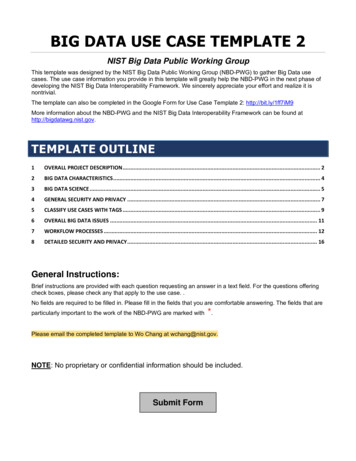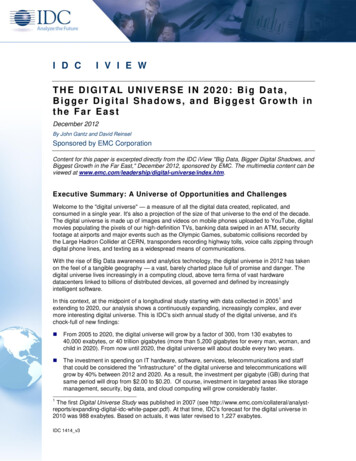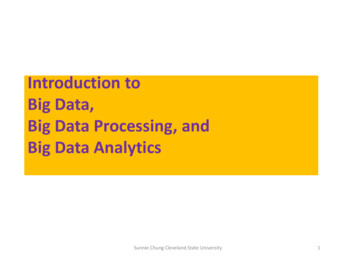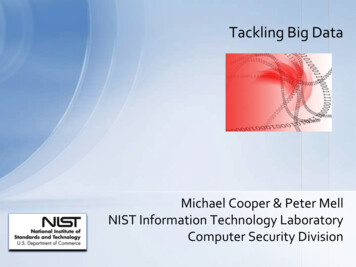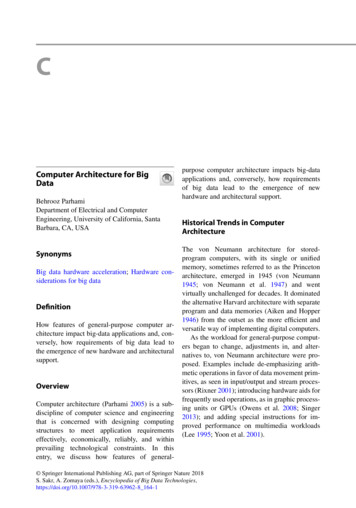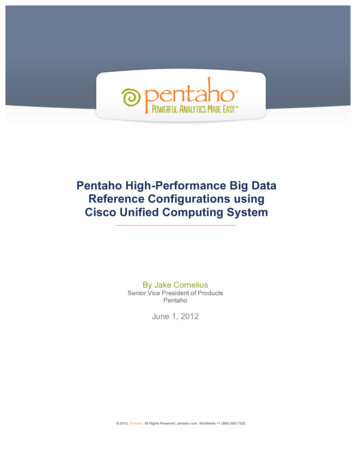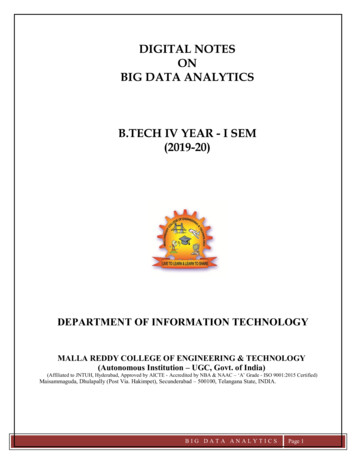
Transcription
DIGITAL NOTESONBIG DATA ANALYTICSB.TECH IV YEAR - I SEM(2019-20)DEPARTMENT OF INFORMATION TECHNOLOGYMALLA REDDY COLLEGE OF ENGINEERING & TECHNOLOGY(Autonomous Institution – UGC, Govt. of India)(Affiliated to JNTUH, Hyderabad, Approved by AICTE - Accredited by NBA & NAAC – ‗A‘ Grade - ISO 9001:2015 Certified)Maisammaguda, Dhulapally (Post Via. Hakimpet), Secunderabad – 500100, Telangana State, INDIA.BIG DATA ANALYTICSPage 1
MALLA REDDY COLLEGE OF ENGINEERING & TECHNOLOGYDEPARTMENT OF INFORMATION TECHNOLOGYSYLLABUS(R15A0530) BIG DATA ANALYTICS (ASSOCIATE ANALYTICS — II)(Elective III)Unit I:Data Management (NOS 2101):Design Data Architecture and manage the data for analysis, understand various sources of Data likeSensors/signal/GPS etc. Data Management, Data Quality (noise, outliers, missing values, duplicate data) andData Pre-processing.Export all the data onto Cloud ex. AWS/Rackspace etc.Maintain Healthy, Safe & Secure Working Environment (NOS 9003):Introduction, workplace safety, Report Accidents & Emergencies, Protect health & safety as your work, courseconclusion, assessmentUnit IIBig Data Tools (NOS 2101):Introduction to Big Data tools like Hadoop, Spark, Impala etc., Data ETL process, Identify gaps in the data andfollow-up for decision making.Provide Data/Information in Standard Formats (NOS 9004):Introduction, Knowledge Management, Standardized reporting & compliances, Decision Models, courseconclusion. Assessment.Unit IIIBig Data Analytics:Run descriptives to understand the nature of the available data, collate all the data sources to suffice businessrequirement, Run descriptive statistics for all the variables and observer the data ranges, Outlier detection andelimination.Unit IVMachine Learning Algorithms (NOS 9003):Hypothesis testing and determining the multiple analytical methodologies, Train Model on 2/3 sample data usingvarious Statistical/Machine learning algorithms, Test model on 1/3 sample for prediction etc.Unit V(NOS 9004)Data Visualization (NOS 2101):Prepare the data for Visualization, Use tools like Tableau, ()lickView and D3, Draw insights out ofVisualization tool. Product ImplementationBIG DATA ANALYTICSPage 2
TEXT BOOK1. Student's Handbook for Associate Analytics.REFERENCE BOOKS:1. Introduction to Data Mining, Tan, Steinbach and Kumar, Addison Wesley, 20062. Data Mining Analysis and Concepts, M. Zaki and W. Meira (the authors have kindly made an onlineversion available): http://www.datamininqbook.info/uoloads/book.pdf3. Mining of Massive Datasets Jure Leskovec Stanford Univ. Anand RajaramanMilliway Labs Jeffrey D.Ullman Stanford Univ.4. (http://www.vistrails.org/index.php/Course: Big Data Analysis)BIG DATA ANALYTICSPage 3
MALLA REDDY COLLEGE OF ENGINEERING & TECHNOLOGYDEPARTMENT OF INFORMATION TECHNOLOGYINDEXS. NoTopicUnitPage no6IDesign Data Architecture and manage the data foranalysisunderstand various sources of Data likeSensors/signal/GPS etc.3IData Management, Data Quality (noise, outliers,missing values, duplicate data)84IData Pre-processing95IExport all the data onto Cloud ex. AWS/Rackspace etc.11Introduction, workplace safety, Report Accidents &Emergencies, Protect health & safety as your work,course conclusion, assessment13IIIntroduction to Big Data tools like Hadoop, Spark,Impala etc, Data ETL process, Identify gaps in the dataand follow-up for decision making.199IIProvide Data/Information in Standard Formats2010IIKnowledge Management2211IIStandardized reporting & compliances2412IIDecision Models, Course conclusion. Assessment2513IIIRun descriptives to understand the nature of the availabledata2814IIIcollate all the data sources to suffice business requirement3215IIIRun descriptive statistics for all the variables and observerthe data ranges331I27I8BIG DATA ANALYTICS7Page 4
16IIIOutlier detection and elimination3617IVHypothesis testing and determining the multipleanalytical methodologies3718IVTrain Model on 2/3 sample data using variousStatistical/Machine learning algorithms,3919IVTest model on 1/3 sample for prediction etc.4020VPrepare the data for Visualization4121VUse tools like Tableau, ()lickView and D34222VDraw insights out of Visualization tool. ProductImplementation43BIG DATA ANALYTICSPage 5
UNIT I Data Management (NOS 2101)Design Data Architecture and manage the Data for analysisData architecture is composed of models, policies, rules or standards that govern which data iscollected, and how it is stored, arranged, integrated, and put to use in data systems and inorganizations. Data is usually one of several architecture domains that form the pillars of anenterprise architecture or solution architecture.Various constraints and influences will have an effect on data architecture design. Theseinclude enterprise requirements, technology drivers, economics, business policies and dataprocessing needs.Enterprise requirementsThese will generally include such elements as economical and effective system expansion,acceptable performance levels (especially system access speed), transaction reliability, andtransparent data management. In addition, the conversion of raw data such as transaction recordsand image files into more useful information forms through such features as data warehouses isalso a common organizational requirement, since this enables managerial decision making andother organizational processes. One of the architecture techniques is the split between managingtransaction data and (master) reference data. Another one is splitting data capture systems fromdata retrieval systems (as done in a data warehouse).Technology driversThese are usually suggested by the completed data architecture and database architecture designs.In addition, some technology drivers will derive from existing organizational integrationframeworks and standards, organizational economics, and existing site resources (e.g. previouslypurchased software licensing).EconomicsThese are also important factors that must be considered during the data architecture phase. It ispossible that some solutions, while optimal in principle, may not be potential candidates due totheir cost. External factors such as the business cycle, interest rates, market conditions, and legalconsiderations could all have an effect on decisions relevant to data architecture.Business policiesBusiness policies that also drive data architecture design include internal organizational policies,rules of regulatory bodies, professional standards, and applicable governmental laws that can varyby applicable agency. These policies and rules will help describe the manner in which enterprisewishes to process their data.Data processing needsThese include accurate and reproducible transactions performed in high volumes, datawarehousing for the support of management information systems (and potential data mining),repetitive periodic reporting, ad hoc reporting, and support of various organizational initiatives asrequired (i.e. annual budgets, new product development).BIG DATA ANALYTICSPage 6
The General Approach is based on designing the Architecture at three Levels of Specification : The Logical Level The Physical Level The Implementation LevelUnderstand various sources of the DataData can be generated from two types of sources namely Primary and SecondarySources of Primary DataThe sources of generating primary data are Observation Method Survey Method Experimental Method Experimental MethodThere are number of experimental designs that are used in carrying out and experiment. However,Market researchers have used 4 experimental designs most frequently. These are CRD - Completely Randomized DesignRBD - Randomized Block Design - The term Randomized Block Design has originated fromagricultural research. In this design several treatments of variables are applied to different blocksof land to ascertain their effect on the yield of the crop. Blocks are formed in such a manner thateach block contains as many plots as a number of treatments so that one plot from each is selectedat random for each treatment. The production of each plot is measured after the treatment is given.These data are then interpreted and inferences are drawn by using the analysis of VarianceTechnique so as to know the effect of various treatments like different dozes of fertilizers,different types of irrigation etc.LSD - Latin Square Design - A Latin square is one of the experimental designs which has abalanced two way classification scheme say for example - 4 X 4 arrangement. In this scheme eachletter from A to D occurs only once in each row and also only once in each column. The balancearrangement, it may be noted that, will not get disturbed if any row gets changed with the other.ABCDBCDACDABDABCBIG DATA ANALYTICSPage 7
The balance arrangement achieved in a Latin Square is its main strength. In this design, thecomparisons among treatments, will be free from both differences between rows and columns.Thus the magnitude of error will be smaller than any other design.FD - Factorial Designs - This design allows the experimenter to test two or more variablessimultaneously. It also measures interaction effects of the variables and analyzes the impacts ofeach of the variables.In a true experiment, randomization is essential so that the experimenter can infer cause and effectwithout any bias.Sources of Secondary DataWhile primary data can be collected through questionnaires, depth interview, focus groupinterviews, case studies, experimentation and observation; The secondary data can be obtainedthrough Internal Sources - These are within the organization External Sources - These are outside the organization Internal Sources of DataIf available, internal secondary data may be obtained with less time, effort and money than theexternal secondary data. In addition, they may also be more pertinent to the situation at hand sincethey are from within the organization. The internal sources includeAccounting resources- This gives so much information which can be used by the marketingresearcher. They give information about internal factors.Sales Force Report- It gives information about the sale of a product. The information provided isof outside the organization.Internal Experts- These are people who are heading the various departments. They can give anidea of how a particular thing is workingMiscellaneous Reports- These are what information you are getting from operational reports.If the data available within the organization are unsuitable or inadequate, the marketer shouldextend the search to external secondary data sources.External Sources of DataExternal Sources are sources which are outside the company in a larger environment. Collectionof external data is more difficult because the data have much greater variety and the sources aremuch more numerous.BIG DATA ANALYTICSPage 8
External data can be divided into following classes.Government Publications- Government sources provide an extremely rich pool of data for theresearchers. In addition, many of these data are available free of cost on internet websites. Thereare number of government agencies generating data. These are:Registrar General of India- It is an office which generates demographic data. It includes details ofgender, age, occupation etc.Central Statistical Organization- This organization publishes the national accounts statistics. Itcontains estimates of national income for several years, growth rate, and rate of major economicactivities. Annual survey of Industries is also published by the CSO. It gives information about thetotal number of workers employed, production units, material used and value added by themanufacturer.Director General of Commercial Intelligence- This office operates from Kolkata. It givesinformation about foreign trade i.e. import and export. These figures are provided region-wise andcountry-wise.Ministry of Commerce and Industries- This ministry through the office of economic advisorprovides information on wholesale price index. These indices may be related to a number ofsectors like food, fuel, power, food grains etc. It also generates All India Consumer Price Indexnumbers for industrial workers, urban, non manual employees and cultural labourers.Planning Commission- It provides the basic statistics of Indian Economy.Reserve Bank of India- This provides information on Banking Savings and investment. RBI alsoprepares currency and finance reports.Labour Bureau- It provides information on skilled, unskilled, white collared jobs etc.National Sample Survey- This is done by the Ministry of Planning and it provides social,economic, demographic, industrial and agricultural statistics.Department of Economic Affairs- It conducts economic survey and it also generates informationon income, consumption, expenditure, investment, savings and foreign trade.State Statistical Abstract- This gives information on various types of activities related to the statelike - commercial activities, education, occupation etc.Non Government Publications- These includes publications of various industrial and tradeassociations, such asThe Indian Cotton Mill AssociationVarious chambers of commerceThe Bombay Stock Exchange (it publishes a directory containing financial accounts, keyprofitability and other relevant matter)Various Associations of Press Media.Export Promotion Council.Confederation of Indian Industries ( CII )BIG DATA ANALYTICSPage 9
Small Industries Development Board of IndiaDifferent Mills like - Woolen mills, Textile mills etcThe only disadvantage of the above sources is that the data may be biased. They are likely tocolour their negative points.Syndicate Services- These services are provided by certain organizations which collect andtabulate the marketing information on a regular basis for a number of clients who are thesubscribers to these services. So the services are designed in such a way that the information suitsthe subscriber. These services are useful in television viewing, movement of consumer goods etc.These syndicate services provide information data from both household as well as institution.In collecting data from household they use three approachesSurvey- They conduct surveys regarding - lifestyle, sociographic, general topics.Mail Diary Panel- It may be related to 2 fields - Purchase and Media. Electronic Scanner Services- These are used to generate data on volume.They collect data for Institutions fromWhole sellersRetailers, andIndustrial FirmsVarious syndicate services are Operations Research Group (ORG) and The Indian MarketingResearch Bureau (IMRB).Importance of Syndicate ServicesSyndicate services are becoming popular since the constraints of decision making are changingand we need more of specific decision-making in the light of changing environment. AlsoSyndicate services are able to provide information to the industries at a low unit cost.Disadvantages of Syndicate ServicesThe information provided is not exclusive. A number of research agencies provide customizedservices which suits the requirement of each individual organization.International Organization- These includesThe International Labour Organization (ILO)- It publishes data on the total and active population,employment, unemployment, wages and consumer pricesThe Organization for Economic Co-operation and development (OECD) - It publishes data onforeign trade, industry, food, transport, and science and technology.The International Monetary Fund (IMA) - It publishes reports on national and internationalforeign exchange regulations.BIG DATA ANALYTICSPage 10
Export all the Data onto the cloud like Amazon web services S3We usually export our data to cloud for purposes like safety, multiple access and real timesimultaneous analysis.There are various vendors which provide cloud storage services. We are discussing Amazon S3.An Amazon S3 export transfers individual objects from Amazon S3 buckets to your device,creating one file for each object. You can export from more than one bucket and you can specifywhich files to export using manifest file options.Export Job ProcesYou create an export manifest file that specifies how to load data onto your device,including an encryption PIN code or password and details such as the name of the bucket thatcontains the data to export. For more information, see The Export Manifest File. If you are goingto mail us multiple storage devices, you must create a manifest file for each storage device.You initiate an export job by sending a CreateJob request that includes the manifest file.You must submit a separate job request for each device. Your job expires after 30 days. If you donot send a device, there is no charge.You can send a CreateJob request using the AWS Import/Export Tool, the AWS Command LineInterface (CLI), the AWS SDK for Java, or the AWS REST API. The easiest method is the AWSImport/Export Tool. For details, seeSending a CreateJob Request Using the AWS Import/Export Web Service ToolSending a CreateJob Request Using the AWS SDK for JavaSending a CreateJob Request Using the REST APIAWS Import/Export sends a response that includes a job ID, a signature value, andinformation on how to print your pre-paid shipping label. The response also saves a SIGNATUREfile to your computer.You will need this information in subsequent steps.You copy the SIGNATURE file to the root directory of your storage device. You can usethe file AWS sent or copy the signature value from the response into a new text file namedSIGNATURE. The file name must be SIGNATURE and it must be in the device's root directory.Each device you send must include the unique SIGNATURE file for that device and that JOBID.AWS Import/Export validates the SIGNATURE file on your storage device before starting thedata load. If the SIGNATURE file is missing invalid (if, for instance, it is associated with adifferent job request), AWS Import/Export will not perform the data load and we will return yourstorage device.BIG DATA ANALYTICSPage 11
Generate, print, and attach the pre-paid shipping label to the exterior of your package. SeeShipping Your Storage Device for information on how to get your pre-paid shipping label.You ship the device and cables to AWS through UPS. Make sure to include your job ID onthe shipping label and on the device you are shipping. Otherwise, your job might be delayed. Yourjob expires after 30 days. If we receive your package after your job expires, we will return yourdevice. You will only be charged for the shipping fees, if any.You must submit a separate job request for each device.NoteYou can send multiple devices in the same shipment. If you do, however, there are specificguidelines and limitations that govern what devices you can ship and how your devices must bepackaged. If your shipment is not prepared and packed correctly, AWS Import/Export cannotprocess your jobs. Regardless of how many devices you ship at one time, you must submit aseparate job request for each device. For complete details about packaging requirements whenshipping multiple devices, see Shipping Multiple Devices.AWS Import/Export validates the signature on the root drive of your storage device. If thesignature doesn't match the signature from the CreateJob response, AWS Import/Export can‘t loadyour data.Once your storage device arrives at AWS, your data transfer typically begins by the end of thenext business day. The time line for exporting your data depends on a number of factors,including the availability of an export station, the amount of data to export, and the data transferrate of your device.AWS reformats your device and encrypts your data using the PIN code or password youprovided in your manifest.We repack your storage device and ship it to the return shipping address listed in yourmanifest file. We do not ship to post office boxes.You use your PIN code or TrueCrypt password to decrypt your device. For moreinformation, see Encrypting Your DataBIG DATA ANALYTICSPage 12
Health, Safety and SecurityWhy Workplace SafetyAsk the question to the participants and gather responses.Discuss the responses with the group to understand the significance of workplacesafety.Basic Workplace Safety GuidelinesPrompt participants to come up with basic safety rules that they follow at theirworkplace. Fire SafetyEmployees should be aware of all emergency exits, including fire escape routes, of theoffice building and also the locations of fire extinguishers and alarms. Falls and SlipsTo avoid falls and slips, all things must be arranged properly. Any spilt liquid, food orother items such as paints must be immediately cleaned to avoid any accidents. Make surethere is proper lighting and all damaged equipment, stairways and light fixtures arerepaired immediately. First AidEmployees should know about the location of first-aid kits in the office. First-aid kitsshould be kept in places that can be reached quickly. These kits should contain all theimportant items for first aid, for example, all the things required to deal with commonproblems such as cuts, burns, headaches, muscle cramps, etc. SecurityEmployees should make sure that they keep their personal things in a safe place. Electrical SafetyEmployees must be provided basic knowledge of using electrical equipment and commonproblems. Employees must also be provided instructions about electrical safety such askeeping water and food items away from electrical equipment. Electrical staff andengineers should carry out routine inspections of all wiring to make sure there are nodamaged or broken wires.BIG DATA ANALYTICSPage 13
Case studies of hazardous eventsCase 1: On Friday, June 13, 1997 a fire broke out at Uphaar Cinema, Green Park, Delhi, whilethe film Border was being shown. The fire happened because of a blast in a transformer in anunderground parking lot in the five-organization building which housed the cinema hall andseveral offices.59 people died and 103 were seriously hurt when people rushed to move out ofthe exit doors. Many people were trapped on the balcony and died because the exit doors werelocked.Case 2: 43 people died when fire broke out on the fifth and sixth floors of the Stephen Courtbuilding in Kolkata.Case 3: 9 people were killed and 68 hurt when a fire accident took place in a commercialcomplex in Bangalore.Case 4: In Kolkata, more than 90 people were killed when a fire broke out at the AdvancedMedicare and Research Institute (AMRI) Hospitals at Dhakuria.Accidents and EmergenciesNotice and correctly identify accidents and emergencies: You need to be aware of whatconstitutes an emergency and what constitutes an accident in an organization. The organization‘spolicies and guidelines will be the best guide in this matter. You should be able to accuratelyidentify such incidents in your organization. You should also be aware of the procedures to tackleeach form of accident and emergency.Follow company policies and procedures for preventing further injury while waiting for helpto arrive: If someone is injured, do not act as per your impulse or gut feeling. Go as per theprocedures laid down by your organization‘s policy for tackling injuries. You need to stay calm andfollow the prescribed procedures. If you panic or act outside the prescribed guidelines, you mayend up further aggravating the emergency situation or putting the injured person into furtherdanger. You may even end up injuring yourself.Act within the limits of your responsibility and authority when accidents and emergenciesarise: Provide help and support within your authorized limit. Provide medical help to the injuredonly if you are certified to provide the necessary aid. Otherwise, wait for the professionals to arriveand give necessary help. In case of emergencies also, act within your authorized limits and let theprofessionals do the task allocated to them. Do not attempt to handle any emergency situation forwhich you do not have formal training or authority. You may end up harming yourself and thepeople around you.BIG DATA ANALYTICSPage 14
Promptly follow instructions given by senior staff and the emergency services: Providenecessary services as described by the organization‘s policy for your role. Also, follow theinstructions of senior staff that are trained to handle particular situations. Work under theirsupervision when handling accidents and emergencies.Types of AccidentsThe following are some of commonly occurring accidents in organizations:Trip and fall: Customers or employees can trip on carelessly left loose material and fall down,such as tripping on loose wires, goods left on aisles, elevated threshold. This type of accident mayresult in simple bruises to serious fractures.Injuries caused due to escalators or elevators (or lifts): Although such injuries are uncommon,they mainly happen to children, ladies, and elderly. Injuries can be caused by falling on escalatorsand getting hurt. People may be injured in elevators by falling down due to sudden, jerkingmovement of elevators or by tripping on elevators‘ threshold. They may also get stuck in elevatorsresulting in panic and trauma. Escalators and elevators should be checked regularly for proper andsafe functioning by the right person or department. If you notice any sign of malfunctioning ofescalators or elevators, immediately inform the right people. If organization‘s procedures are notbeing followed properly for checking and maintaining these, escalate to appropriate authorities inthe organization.Accidents due to falling of goods: Goods can fall on people from shelves or wall hangings andinjure them. This typically happens if pieces of goods have been piled improperly or kept in aninappropriate manner. Always check that pieces of goods are placed properly and securely.Accidents due to moving objects: Moving objects, such as trolleys, can also injure people in theorganization. In addition, improperly kept props and lighting fixtures can result in accidents. Forexample, nails coming out dangerously from props can cause cuts. Loosely plugged in lightingfixtures can result in electric shocks.Handling AccidentsTry to avoid accidents in your organization by finding out all potential hazards and eliminatingthem. If a colleague or customer in the organization is not following safety practices andprecautions, inform your supervisor or any other authorized personnel. Always remember that oneperson‘s careless action can harm the safety of many others in the organization. In case of an injuryto a colleague or a customer due to an accident in your organization, you should do the following:BIG DATA ANALYTICSPage 15
Attend to the injured person immediately. Depending on the level and seriousness of the injury,see that the injured person receives first aid or medical help at the earliest. You can give medicaltreatment or first aid to the injured person only if you are qualified to give such treatments. Lettrained authorized people give first aid or medical treatment.Inform your supervisor about the accident giving details about the probable cause of accident anda description of the injury.Assist your supervisor in investigating and finding out the actual cause of the accident. Afteridentifying the cause of the accident, help your supervisor to take appropriate actions to preventoccurrences of similar accidents in future.Each organization also has policies and procedures to tackle emergency situations. The purpose ofthese policies and procedures is to ensure safety and well-being of customers and staff duringemergencies. Categories of emergencies may include the following:Medical emergencies, such as heart attack or an expectant mother in labor: It is a medicalcondition that poses an immediate risk to a person‘s life or a long-term threat to the person‘s healthif no actions are taken promptly.Substance emergencies, such as fire, chemical spills, and explosions:Substance emergency is an unfavourable situation caused by a toxic, hazardous,or inflammable substance that has the capability of doing mass scale damage toproperties and people.Structural emergencies, such as loss of power or collapsing of walls: Structural emergency is anunfavourable situation caused by development of some faults in the building in which theorganization is located. Such an emergency can also be caused by the failure of an essentialfunction or service in the building, such as electricity or water supply failure. Such emergenciesresult in a long-term or permanent disruption of the organization‘s functions.Key PointsSecurity emergencies, such as armed robberies, intruders, and mob attacks or civil disorder:Security emergency is an unfavourable situation caused by a breach in security posing a significantdanger to life and property.Natural disaster emergencies, such as floods and earthquakes: It is an emergency situationcaused by some natural calamity leading to injuries or deaths, as well as a large-scale destruction ofproperties and essential service infrastructures.BIG DATA ANALYTICSPage 16
Facilitators Guide – SSC/ Q2101 – Associate Analytics– Protect Health & Safety as You WorkHere are some potential sources of hazards in an organization:Using computers: Hazards include poor sitting postures or excessive duration of sitting in oneposition. These hazards may result in pain and strain. Making same movement repetitively canalso cause muscle fatigue In addition, glare from the computer screen can be harmful to eyes.Stretching up at regular intervals or doing some simple yoga in your seat only can mitigate suchhazards.Handling office equipment: Improper handling of office equipment can result in injuries. Forexample, sharp-edged equipment if not handled properly can cause cuts. Staff members should betrained to handle equipment properly. Relevant manual should be made available byadministration on handling equipment.Handling objects: Lifting or moving heavy items without proper procedure or techniques can bea source of potential hazard. Always follow app
(R15A0530) BIG DATA ANALYTICS (ASSOCIATE ANALYTICS — II) (Elective III) Unit I: Data Management (NOS 2101): Design Data Architecture and manage the data for analysis, understand various sources of Data like Sensors/signal/GPS etc. Data Management, Data Quality (noise, outliers, missing values, duplicate
